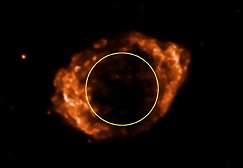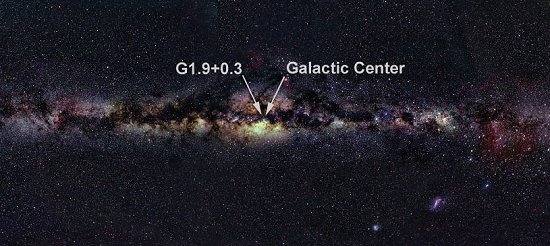The Chandra Space Telescope discovered that the remnants of a supernova discovered near the center of the galaxy are from a supernova that appeared in the sky 140 years ago but was not visible due to the veil of dust in the area where it occurred

The explosion took place about 140 years ago (from our point in time, ignoring the distance, of course, meaning that if it had been observed from Earth it would have been visible in the seventies of the 19s), which makes it one of the freshest supernovae in the Milky Way measured on the scale of modern science. Before that, the known supernova was the one that appeared in 1680. These estimates were based on the spread of the Irisia, Cassiopeia A.
This young supernova remnant, which astronomers have named G1.9+0.3, the numbers indicating the galactic coordinates where the spreading cloud of supernova remnants is located, lies deep within the heart of the Milky Way galaxy. The explosion itself was not visible because it went down in a compressed field of gas and dust. This makes the object a million times dimmer in visible light than a supernova that can be observed without rebuttal. However, the remnants left behind by the supernova can be observed in the X-ray and radio telescopes.
"We can see supernova explosions with optical telescopes halfway across the universe, but when there's dust we can't even observe our own cosmic backyard," says Steven Reynolds of the University of Northern California in Raleigh, who led the study on the Chandra data. "Fortunately, the cloud of gas spreading from the diaspora has been shining brightly in radio waves and X-rays for thousands of years. Telescopes operating in these two frequency ranges can see through the dust screen and show us what we missed.
Astronomers observe supernovae in other galaxies. Based on these observations they estimate that at least three such explosions should occur in a century in our galaxy. If this rate is correct, there should be ten apparent supernova explosions from Cassiopeia A, says David Green of the University of Cambridge in the UK, who led the study on behalf of the Very Large Array. "It's a big moment to follow one of them," he said.
Tracking the object began in 1985, when astronomers led by Greene used the Very Large Array to detect the remnants of a supernova explosion near the center of our galaxy. Based on the relatively small diameter, they estimated that it was a supernova that exploded between 400 and 22 years ago. 16 years later, observations from Chandra revealed that the object has spread considerably, about 1985% since XNUMX. This indicates that the supernova remains are much younger than previously thought.
The young age was confirmed last week when the Very Large Array made new radio observations. They compared it to the previous photographs, and they show that the age of the remains does not exceed 140 years - maybe even less if they slowed down due to the dust - which makes the supernova the youngest recorded in the Milky Way.
In addition to being a new supernova, the object is also interesting for other reasons. The high propagation speed and high energies of the particles created are high and may accelerate in-depth studies of the object using Chandra and the Very Large Array. "No object in our galaxy has these properties," said Reynolds. "This finding is particularly important to learn more about how some stars explode and what happens next."

Pictured: The envelope of matter spreading from the supernova as photographed by Chandra in 2007. The central circle depicts the size of the envelope in 1985.

One response
In the picture it seems as if the aura is shifted in the "NW-E" direction, i.e. in the hour direction
11-10 of the picture. As if under the influence of a cosmic "spirit".
Does this indicate the existence of another star near the super nova?